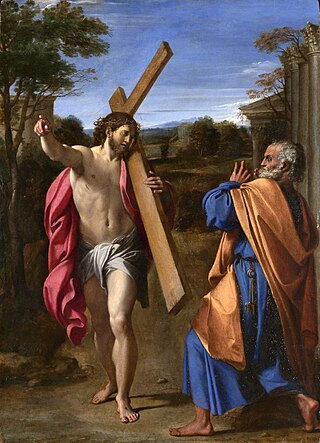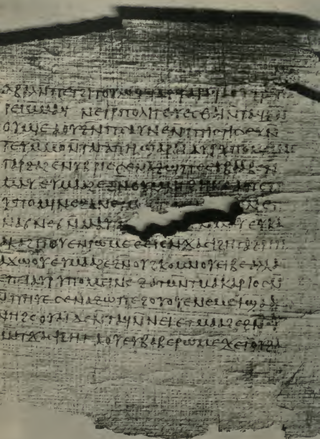
Quo vadis? is a Latin phrase meaning "Where are you going?" It is also commonly translated poetically as "Whither goest thou?"

John the Apostle or Saint John the Beloved was one of the Twelve Apostles of Jesus according to the New Testament. Generally listed as the youngest apostle, he was the son of Zebedee and Salome. His brother James was another of the Twelve Apostles. The Church Fathers identify him as John the Evangelist, John of Patmos, John the Elder, and the Beloved Disciple, and testify that he outlived the remaining apostles and was the only one to die of natural causes, although modern scholars are divided on the veracity of these claims.

Santa Maria in Palmis, also known as Chiesa del Domine Quo Vadis, is a small church southeast of Rome. It is located about some 800 m from Porta San Sebastiano, where the Via Ardeatina branches off the Appian Way, on the site where, according to the apocryphal Acts of Peter, Saint Peter met the risen Christ while Petrus was fleeing persecution in Rome. According to the tradition, Peter asked him, "Lord, where are you going?". Christ answered, "I am going to Rome to be crucified again".

Simon the Zealot or Simon the Canaanite or Simon the Canaanean was one of the most obscure among the apostles of Jesus. A few pseudepigraphical writings were connected to him, but Jerome does not include him in De viris illustribus written between 392 and 393 AD.

Acts of Thomas is an early 3rd-century text, one of the New Testament apocrypha within the Acts of the Apostles subgenre. References to the work by Epiphanius of Salamis show that it was in circulation in the 4th century. The complete versions that survive are Syriac and Greek. There are many surviving fragments of the text. Scholars detect from the Greek that its original was written in Syriac, which places the Acts of Thomas in Edessa, likely authored before 240 AD. The surviving Syriac manuscripts, however, have been edited to purge them of the most unorthodox overtly Encratite passages, so that the Greek versions reflect the earlier tradition.

The Gospel of Nicodemus, also known as the Acts of Pilate, is an apocryphal gospel claimed to have been derived from an original Hebrew work written by Nicodemus, who appears in the Gospel of John as an associate of Jesus. The title "Gospel of Nicodemus" is medieval in origin. The dates of its accreted sections are uncertain, but the work in its existing form is thought to date to around the 4th or 5th century AD.
Leucius, called Leucius Charinus by Photios I of Constantinople in the ninth century, is named by Evodius, bishop of Uzala, as the author of a cycle of what M. R. James termed "Apostolic romances". These works seem to have had wide currency long before a selection from them was read aloud at the Second Council of Nicaea (787) and then rejected. Leucius is not among the early heretical teachers mentioned by name in Irenaeus' Adversus haereses. Most of the works seem to be products of the mid-third century.

The New Testament apocrypha are a number of writings by early Christians that give accounts of Jesus and his teachings, the nature of God, or the teachings of his apostles and of their lives. Some of these writings were cited as scripture by early Christians, but since the fifth century a widespread consensus has emerged limiting the New Testament to the 27 books of the modern canon. Roman Catholic, Eastern Orthodox, and Protestant churches generally do not view the New Testament apocrypha as part of the Bible.

The Acts of Paul and Thecla is an apocryphal story–Edgar J. Goodspeed called it a "religious romance"–of Paul the Apostle's influence on a young virgin named Thecla. It is one of the writings of the New Testament apocrypha.

The Acts of Andrew, is the earliest testimony of the acts and miracles of the Apostle Andrew. The surviving version is alluded to in a 3rd-century work, the Coptic Manichaean Psalter, providing a terminus ante quem, according to its editors, M. R. James (1924) and Jean-Marc Prieur in The Anchor Bible Dictionary, but it shows several signs of a mid-2nd-century origin. Prieur stated that "The distinctive christology of the text" and its lack of mention of church organisation, liturgy, and ecclesiastical rites, lead one to "militate for an early dating". By the 4th century, the Acta Andreae were relegated to the New Testament apocrypha.

The seventy disciples or seventy-two disciples, known in the Eastern Christian traditions as the seventy apostles or seventy-twoapostles, were early emissaries of Jesus mentioned in the Gospel of Luke. The correct Greek terminology is evdomikonta (ἑβδομήκοντα) apostoli or evdomikonta mathetes.

The Cross of Saint Peter, also known as the Petrine Cross, is an inverted Latin cross traditionally used as a Christian symbol, but in recent times it has also been used as an anti-Christian and Satanic symbol. In Christianity, it is associated with the martyrdom of Peter the Apostle. The symbol originates from the Catholic tradition that when sentenced to death, Peter requested that his cross be upside down, as he felt unworthy of being crucified in the same manner as Jesus.

The Acts of Paul is one of the major works and earliest pseudepigraphal series from the New Testament apocrypha also known as Apocryphal Acts. This work is part of a body of literature either about or purporting to be written by Paul the Apostle, including letters, narratives, prayers, and apocalypses. An approximate date given to the Acts of Paul is 100-160 AD. The Acts of Paul were first mentioned by Tertullian, who deemed the work to be heretical because it encouraged women to preach and baptize. The Acts of Paul were considered orthodox by Hippolytus of Rome but were eventually regarded as heretical when the Manichaeans started using the texts. The author of the Acts of Paul is unknown, but probably came from a Christian community in Asia Minor that revered Paul. The work does not use the canonical Acts of the Apostles as a source; instead it relies on oral traditions of Paul's missionary work. The text is primarily known from Greek manuscripts. The discovery of a Coptic language version of the text demonstrated that the text was composed of:

The Epistle of the Apostles is a work of New Testament apocrypha. Despite its name, it is more a gospel or an apocalypse than an epistle. The work takes the form of an open letter purportedly from the remaining eleven apostles describing key events of the life of Jesus, followed by a dialogue between the resurrected Jesus and the apostles where Jesus reveals apocalyptic secrets of reality and the future. It is 51 chapters long. The epistle was likely written in the 2nd century CE in Koine Greek, but was lost for many centuries. A partial Coptic language manuscript was discovered in 1895, a more complete Ethiopic language manuscript was published in 1913, and a full Coptic-Ethiopic-German edition was published in 1919.

The Greek Acts of Philip is an episodic gnostic apocryphal book of acts from the mid-to-late fourth century, originally in fifteen separate acta, that gives an accounting of the miraculous acts performed by the Apostle Philip, with overtones of the heroic romance.

Domine, quo vadis? is a 1602 painting by the Italian Baroque painter Annibale Carracci (1560–1609), depicting a scene from the apocrypha Acts of Peter. It is housed in the National Gallery, where it is given the title Christ appearing to Saint Peter on the Appian Way. The subject is a rare representation in art of the theme Quo vadis. Annibale Carracci was the founder of the Italian Baroque painting school, called Bolognese School. This painting is one of his best known works. Peter is depicted fleeing Rome to avoid crucifixion and has a vision of meeting Christ bearing his Cross. Peter asks Jesus "Quo vadis?" to which he replies, "Romam vado iterum crucifigi". Peter returns to Rome after this vision.

The Acts of the Apostles is a genre of early Christian literature, recounting the lives and works of the apostles of Jesus. The Acts are important for many reasons, one of them being the concept of apostolic succession. They also provide insight into the valuation of "missionary activities among the exotic races," since some of them feature missionary work done among, for instance, the Cynocephaly.

Saint Peter, also known as Peter the Apostle, Simon Peter, Simeon, Simon, or Cephas, was one of the Twelve Apostles of Jesus Christ and one of the first leaders of the early Christian Church. He appears repeatedly and prominently in all four New Testament gospels as well as the Acts of the Apostles. Catholic and Orthodox tradition accredits Peter as the first bishop of Rome—or pope—and also as the first bishop of Antioch.
"Quo Vadis, Captain Chandler?" was the 81st episode of the M*A*S*H television series, and the ninth of season four. The episode aired on November 7, 1975. "Quo Vadis" is Latin for "Where are you going?" and is a reference to a conversation recounted in the apocryphal Acts of Peter in which Peter, fleeing his ministry and the threat of crucifixion in Rome, meets Jesus on the road, who has risen. Peter asks Jesus "Quo Vadis?," to which Jesus responds that he is going to Rome to be crucified again. This gives Peter the courage to return to his ministry in Rome, where he ultimately ends up crucified upside down.

Acts 4 is the fourth chapter of the Acts of the Apostles in the New Testament of the Christian Bible. The book containing this chapter is anonymous but early Christian tradition affirmed that Luke composed this book as well as the Gospel of Luke. This chapter records the aftermath of a healing by Simon Peter and his preaching in Solomon's Portico, that Sanhedrin arrested the apostles, but had to let them go.













